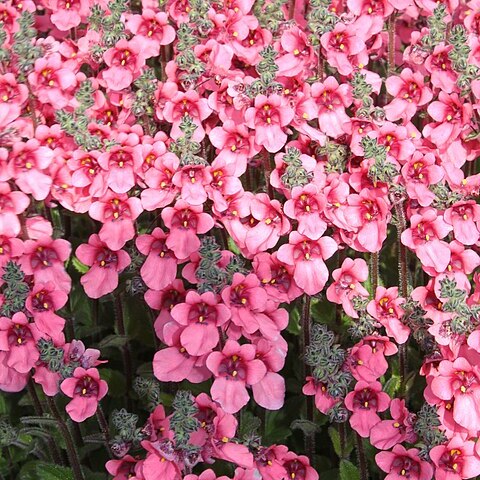Stoloniferous perennial herb, stems many from the crown, tufted, branching, up to c. 400 mm long, c. 2 mm diam., decumbent or suberect, softly pilose, hairs patent, gland-tipped. Leaves mostly 15-24 x 15-25 mm, rarely much smaller or much larger, ratio 1-1.5:1, ovate, base ± cordate, apex obtuse to rounded, margins serrate, both surfaces with long patent gland-tipped hairs or hairs sparse or wanting; petioles 1-7 mm long, glandular-pilose to glabrous. Flowers several to many in lax terminal racemes; bracts mostly up to 7 x 7 mm, usually sharply differentiated from the leaves, the lowermost occasionally leaf-like, ovate-cordate, glandular; pedicels 15-25 mm long, ascending at angle of c. 45°-90°, glandular-pilose, hairs mostly 0.5 mm long. Calyx segments lanceolate, reflexed, two anticous ones c. 3-6 x 1-1.5 mm, three posticous ones slightly smaller, all green, pilose outside with patent gland-tipped hairs. Corolla tube c. 4-5 mm long, strongly invaginated, two lateral spurs c. 5-7 mm long, strongly curved forward, with a patch of dark sessile glands within at the tips; limb c. 20-24 x 15-21 mm, anticous lobe broadly ovate, c. 10-14 x 10-13 mm, two lateral lobes subrotund, c. 5-6 x 5.5-7 mm, two posticous lobes subrotund, c. 5-6 x 4-5 mm, all lobes rose-pink, sparsely glandular-pilose outside, inside usually with, rarely without, a transversely elongated central patch of dark sessile glands on the front of the palate, which is channelled down the back to accommodate the forward thrust of the invaginated corolla tube, the “window” concave, forming a small conical spur 1.5-2.5 mm deep, 4-5 mm across at the base, yellow and maroon. Stamens projecting forward from the base of the boss formed by the invaginated corolla tube; filaments 3-4 mm long, glandular-pilose; anthers c. 0.75-1 mm long, cohering strongly, pollen yellow. Ovary 1.5-2 x 1-1.5 mm, deltoid in outline, ovules many in each loculus; style 2-3 mm long, stigma capitate, lying in the centre of the anthers. Capsule 7-12 x 3.5-4 mm, urceolate; seeds 1.5 mm long, curved, winged and ridged.
More
Perennial herb, ± erect or decumbent with stolons, up to 400 mm long; stems tufted, branched. Leaves ovate, ± obtuse; petioles 1-7 mm long. Flowers: pedicels 15-25 mm long, ascending. Corolla: lobes pink shades, rarely red, usually with a transverse patch of dark sessile glands on centre front of palate; window hollow, like a small cone. Spurs 5-7 mm long, much curved forward. Flowering time Nov.-Mar., mostly Jan.

